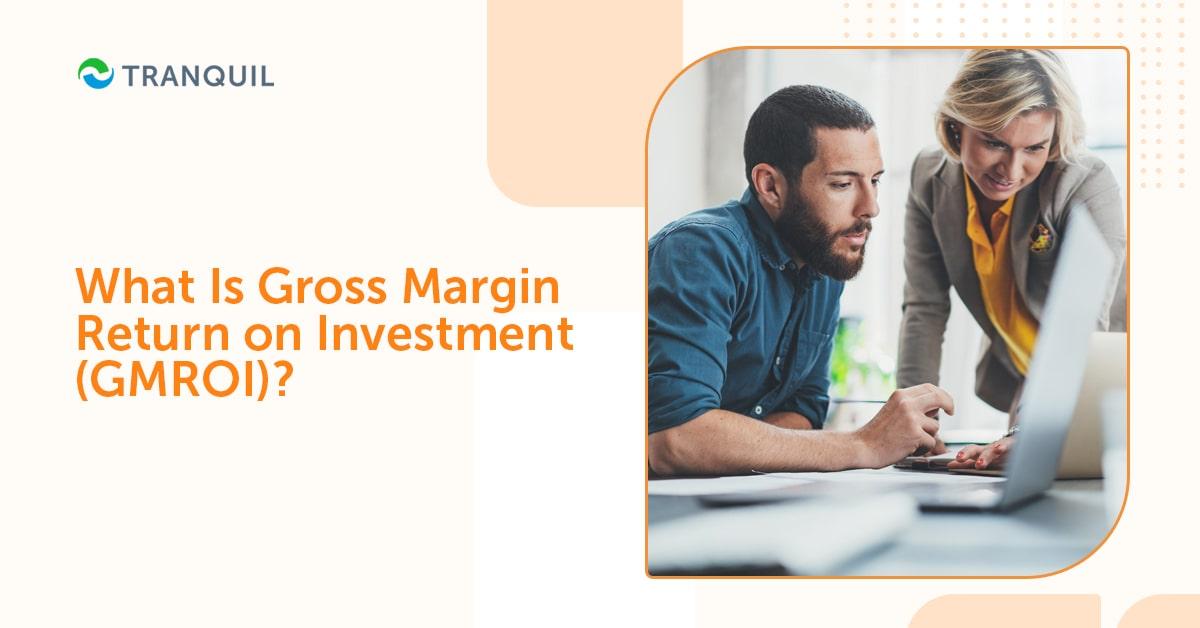
GMROI or gross margin return on investment is a ratio that assesses the profitability of inventory.
It fundamentally studies the ability of a company to convert inventory into money for an amount over the inventory cost.
It is mainly used by retail businesses; the calculation in itself is a simple one, and the ratio is useful as it gives visibility into the average inventory returns over its cost.
It is therefore also known as the gross margin return on inventory investment.
ALSO READ: Detailed Guide on ROI on ERP Implementation
We have already seen that the GMROI helps the business owner or investor to understand what is the average sum over its cost that is returned by the inventory.
A ratio below one means that the business is selling products for less than what they spent to purchase it; if it is above one, it means that the firm is selling the products at a price that is above the acquisition cost.
It means that the firm has balanced inventory cost, margin, and sales effectively.
Some industry experts opine that a ratio of a minimum of 3.2 is required for covering all the costs related to labor and occupancy, as well as the profit are met.
ALSO READ: What is Dropshipping and it’s Benefits?

There are various approaches to measuring of the gross margin return on inventory investment, depending on the unique accounting systems of various businesses.
Retail firms incur different types of expenses every month like storage, rent/lease payments, transportation, labor, marketing, utilities, and so on.
More or less, the formula is similar, with only the specific expenses considered being different, based on the goals of individual businesses.
Put in its simplest form, the formula is: Gross Margin/Average Cost of Inventory = GMROI.
For the purposes of internal accounting, retailers may use their own version of this formula, to get different figures.
ALSO READ: Detailed Guide on Budget Variance Analysis
Let us say that a retailer wants to calculate this margin as a percentage, using this formula:
First, from the Revenue, the Cost of Goods Sold is subtracted.
This figure is divided by Revenue in the next step and multiplied by 100.
[(Revenue – Cost of Goods Sold) / Revenue] *100 = Gross Margin percentage.
Eventually, the exact formula depends on several variables, mainly, the internal accounting system of each company.
This number can be presented in monetary value terms – like SAR, a percentage, or a ratio; however, its purpose stays the same – that is, measuring how profitable is your investment in inventory.
It is important to calculate two key metrics: average inventory and gross margin.
When you deduct the cost of goods sold from a company’s revenue, you get the gross profit.
This is then divided by the revenue, as we have seen above.
To calculate the average inventory across a specific period, you total the closing inventory for that specific time period, and divide it by how may periods were there periods in it.
You also have to consider the situation of obsolete inventory.
ALSO READ: Importance of Cash Book in Accounting

Let us try and understand this with the help of an example:
Suppose retailer A has an annual income of SAR 100 million, and their cost of goods sold is SAR 40 million when the financial year ends.
This means that the company’s gross margin is at 60%, meaning, it retains 0.6 Riyals for every Riyal.
If we state the gross margin in terms of SAR: let us assume that the average inventory cost for the company at the financial year end is SAR 15 million.
Then the firm’s gross margin return on investment is SAR 60 million/15 million = 4.
That translates into 400% of expenses, this means, retailer A sells their goods for a markup of a minimum of SAR 4 for every Riyal invested in inventory.
ALSO READ: What is Storage Cost of Inventory?
Let’s look at their competitor, Retailer Z. With a total income of SAR 100 million, their cost of goods sold is 80 million.
Their gross margin is SAR 20 million, meaning they retain 0.2 Riyals for every Riyal spent on inventory.
Assuming their average cost of inventory is 25 million, their GMROI is SAR 20 million/SAR 25 million.
This means it earns about 80% of its expenses or is getting a margin of 0.8 Riyals for every Riyal spent on inventory.
Now when we compare, we see that Retailer Z is only making 0.8 Riyal per Riyal spent, and that is in no way sufficient to meet marketing, administrative, wages, and other expenses of the business.
Retailer A on the other hand is doing a much better job.
If I were to invest my money, I would do that in the business of Retailer A.
ALSO READ: What is Landed Cost and How to Calculate It?
The gross margin return on inventory investment ratio is useful in many ways:
ALSO READ: Importance and Calculation of Safety Stock

A GMROI over SAR 1 does show that you are indeed making profits on the inventory; however, it may not be sufficient to cover your entire business expenses.
A low GMROI even though it’s positive, may still be indicative of poor business performance.
That begs the question, what exactly is a good ratio of GMROI for retail businesses?
Well this is not an easy question to answer as each business in the retail industry is unique, and the average GMROI can differ depending on the type of retail business you are in.
ALSO READ: What is Inventory Aging?
For example, a mobile dealer and a greengrocer are likely to have very different ‘good’ GMROIs.
Similarly, the market segment – luxury or economy – also matters.
Retailers who have large sales volumes usually have smaller margins as they need excess inventory for their operations.
SKUs with large stock turn normally have low margins.
On the other hand, high-end items with high margins move slowly and contribute to a slightly lower GMROI overall.
So, for some retailers SAR 2 may be indicative of a healthy business; for some, this may be too low and for some, it may be unattainable.
Eventually, how good a GMROI a retailer attains, completely rests on the degree of control a retailer exercises over expenses and prices.
Ergo, retailers who deal with vendors that dictate costs, or those doing business in very competitive markets are likely to have a lower GMROI.
Retailers who deal with specialty products, make their own products, or are more vertically integrated, are likely to have a higher GMROI.
Similarly, high-end brands will have a higher GMROI than discount ones, as the ratio depends significantly on the market position enjoyed by the business.
To know what is a good GMROI for you, compare your business to similar businesses – in the same vertical and category.
ALSO READ: Top Inventory Reduction Strategies

To do this, you need to take a series of actions; remember that these actions make up a general approach toward GMROI, no matter which industry you are in.
Experts tell us that the following stages are critical:
We have seen that if something is not right about your inventory investment, you are likely to have low GMROI.
It means that you are purchasing more stock than what you sell.
If you improve your sales or demand forecasting, you will be able to make better inventory decisions in terms of purchase.
Knowing how much to buy to maximize sales will automatically increase your GMROI.
While the GMROI is inextricably connected to the unit price, merely increasing it will not necessarily increase your GMROI.
In fact, the price rise may be followed by a dip in sales.
What you need to do is optimize prices so that they remain competitive (unless you are selling a high-end, exclusive product) and don’t experience a decrease in sales.
This strategy of optimizing prices will help you to boost your GMROI.
ALSO READ: Complete Guide on Economic Order Quantity (EOQ)
You need to have smart, innovative strategies on inventory.
With customers becoming more discerning and tech-savvy, they demand more flexible pricing choices, and cutting inventor costs in time can help enhance the GMROI significantly.
Storing inventory units cost-effectively is a key aspect in boosting GMROI.
ALSO READ: Sales Order vs Purchase Order
We have seen that the GMROI is a ratio of inventory profitability that tells us how quickly or efficiently an organization can convert its inventory into cash.
This value is applicable mostly to businesses that rely on stocks heavily for their business – chiefly, the retail industry.
It is the most apt for GMROI consideration.
The GMROI tree for retail has many important features.
ALSO READ: Benefits of Goods Received Note (GRN)
The GMROI is a valuable tool for retailers to know how efficient their inventory strategy is.
All you need to do is calculate the gross margin and the cost of inventory.
Optimize prices, reduce inventory costs, and improve your forecast precision, and you’ll achieve a higher GMROI.
Sounds like a tall order? Doing all of this manually can be cumbersome and time-consuming, after all.
Efficient inventory management is critical for any business, and for retailers, it is absolutely crucial.
Manually doing all of this can be exhausting; you may also have more errors, and tie up your employees for long periods.
Switch to a robust, cloud-based ERP like Tranquil to automate and streamline your inventory management process with its feature-packed Inventory Management module.
Maintain optimal stocks of inventory, enjoy continuous sales, reduce costs, maximize profitability, and achieve business growth.
ALSO READ: How to Manage Backordering?
If you’re not sure how Tranquil ERP can benefit your business, do book a demo at a time of your convenience. Our team will be at hand to explain everything and answer all your queries.